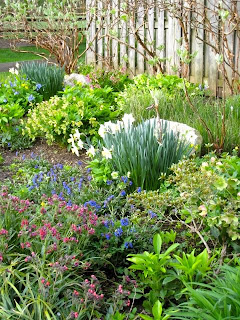March
is a guessing game in the garden. Will
it snow or rain? Will it warm up
soon? Will it stay warm? Should I remove the winter protection from
plants? About the only thing we can
count on is that March to shall pass and maybe April will let us do more
gardening.
March is the month to start many
seeds for transplants. Be sure to uses a
soil-less mix to avoid damping off, a seedling disease common when using mixes
that contain soil.
To determine when to start your
flower and vegetable transplants, count back from the date plants can safely be
set out in your area. As a rule most
flowers and vegetables need to be started about six to eight weeks before
transplanting time.
Check the seed packet to determine
if the seeds can be started indoors or should be sown directly in the ground
when the weather warms. Starting seeds
indoors not only gives you a jump on the growing season, often leading to
earlier harvests, but also allows you to have many varieties you can’t find at
greenhouses and garden stores.
Early March is a perfect time to
finish the pruning of fruit trees, ornamental trees, and summer-flowering
shrubs, providing you do it before the buds start to swell. Wait to prune spring-flowering shrubs until
they’ve bloomed, however, or you’ll cut off the buds and won’t get any flowers.
Always use sharp pruning
shears. Make your cuts as close to the
branch as possible as this will help the tree heal its wounds. Prune to provide good branch angles (about
45°) and allow adequate air circulation and sunlight penetration. This is also a good time to remove branches
and limbs damaged in winter storms. Just
don’t mistake dormant twigs for winter kill and snap them off!
Easter is early this year – March
31. The flower that most often comes to
mind, when we think of Easter, is the Easter lily. Choose a well-proportioned plant, one that’s
about two times as high as the pot.
Check the buds, flowers, and leaves – especially the undersides – for
signs of insect pests and disease.
To keep your lily healthy at home,
remove the decorative foil or paper covering the pot, or make a hole in the
bottom, to allow better drainage. Put
your plant where it will get plenty of bright, indirect light and cool
temperatures. About 40 to 50° F at night
and below 68° F during the day is ideal.
Keep the soil constantly moist. To prolong the life of the blossoms, remove
the yellow, pollen-bearing pods or anthers found in the center of each flower.
DON’T
expect your lily to flower again as it’s already been “forced” once by the
grower to bloom in time for Easter.
However, you might get your lily to bloom again next fall by planting it
outdoors once the soil has warmed up.
While
you are waiting for the soil to dry, here are a few late winter chores:
• Check out your garden tools, patio
furniture, window boxes, etc. Paint,
repair or discard so
you are ready to go when it’s really nice out.
• Begin to transplant pot-bound houseplants.
• Continue to inspect houseplants for pests
and control as needed.
• Cut back leggy houseplants.
• You can start fertilizing houseplants but
don’t fertilize the lawn until it has been mowed a few times.
• Order seeds!
Hey that’s always fun. Try
something new this year!
You don’t have to be Irish to buy a
shamrock plant this month in celebration of St. Patrick’s Day. Shamrocks, a member of the Oxalis family, are
easy to grow and are available at many garden centers and florist shops. Like most houseplants, they prefer a sunny
location and need periodic watering to ensure an evenly moist soil.

